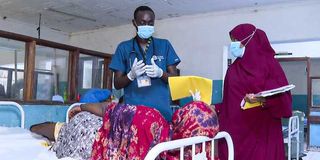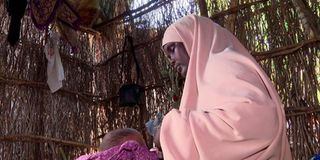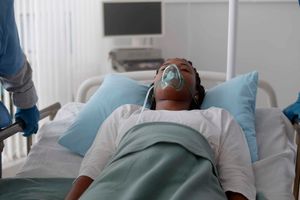Hagadera miracle births: Flipping the negative pregnancy and childbirth narrative for refugee mothers

Dr Silas Chirchir attending to a patient at the Hagadera Refugee Camp Hospital in Daadab Garissa County.
Under a tarpaulin tent pitched in one of the largest refugee settlements in Kenya, Nadhifa Yusuf is breastfeeding her bundle of joy. She keeps observing the one-month-old baby to ensure that she’s latching on correctly.
Amidst the chaos of displacement and uncertainty at Hagadera Refugee Camp in Dadaab, Garissa County, a newborn is always a reason for celebration. Inside this camp where resources are scarce and the spectre of maternal and child mortality looms large, each birth is considered a testament to the strength and courage of the women who keep hope alive against all odds.
Nadhifa, a mother of seven, knows too well the pain of lacking healthcare services during pregnancy and at childbirth.
Luckily, this time round her baby was delivered safely, all thanks to thorough healthcare before, during and after birth at Hagadera Hospital, the only health facility in the camp.

Nadhifa Yusuf with her newborn at Hagadera Refugee Camp in Daadab,Garissa County, on March 4, 2024.
But that has not always been the case.
Her first three children were delivered at home.
For many expectant mothers in refugee camps like Nadhifa, the childbirth process is fraught with peril. The lack of basic healthcare services, skilled birth attendants and essential medical supplies leaves them vulnerable and exposed to life-threatening complications.
With no hospitals or clinics nearby, women often resort to delivering in crowded tents or rudimentary shelters, with just a loved one’s hands to offer support.
In the absence of trained healthcare professionals, childbirth becomes a perilous journey into the unknown. Complications such as postpartum haemorrhage, infections and obstructed labour pose grave risks to both mother and child.
Nadhifa, who has lived at the camp for 13 years, recalls losing her second child to stillbirth (a baby born with no signs of life at or after 22 weeks of pregnancy) 12 years ago.
Her pregnancy was a smooth journey filled with joy and anticipation. However, she began to notice that something was amiss at the 22nd week. The baby’s movements were replaced by unsettling stillness, but she kept convincing herself that everything was fine.
Nadhifa then developed a sharp pain in her abdomen, sending her into panic. Hours later, she lost her pregnancy.
Even worse, she did not go for check-up because the only available hospital was too far away.
“When I was expecting my second child, I developed complications — abdominal and back pains. I gave birth to a stillborn baby. There was no strong referral system, and a majority of us gave birth at home. It is only after the introduction of a number of initiatives where we could be followed to go to the hospital that I started doing so for my subsequent deliveries,” says Nadhifa.
She add: “I gave birth to my first born by the roadside. I just felt something was coming out and before I could rush home, the baby came out.”
For thousands of women in Kenya’s refugee camps, their aspirations of becoming mothers have been shattered. They are left grappling with the inexplicable loss of their babies.
However, amidst the chaos, there is a glimmer of hope. It was until the International Rescue Committee, a global humanitarian organisation, introduced a number of initiatives at the camp and at Hagadera Hospital that mothers started delivering in the health facility.
Nadhifa is one of the mothers who has since embraced antenatal check-ups hospital deliveries, all thanks to follow-ups by safe motherhood promoters. These are mothers who were previously traditional birth attendants and have since been trained on how to notice danger signs in pregnancy. They ensure that expectant women at the camp attend all their scheduled clinics and even accompany them to deliver in the hospital.
The safe motherhood initiative has seen Nadhifa’s last four children delivered at Hagadera Hospital. When she was expecting her last-born child last year, she fell ill and her pregnancy was categorised as high risk. It is at this time that she was enrolled into the safe motherhood promoter initiative that saw her being monitored closely for nine months.
During delivery, she had prolonged labour and doctors advised her to go for caesarian-section, which she declined.
“I arrived at the hospital at 7am only to give birth at 1pm after a long wait for my relatives to give consent for me to go for the procedure. In my culture, many people are opposed to caesarian-section.
“Fortunately during the wait, the cervix opened and I gave birth normally,” she tells the Healthy Nation team at her home in Block D at the camp.
She was discharged after 24 hours. Her blood pressure was high and she was given a portable machine to monitor it every evening.
“I want to believe that with the accessibility of these services, more women are likely to carry their babies to term and even give birth safely. Previously, we were giving birth at home because there were limited resources such as ambulances to take us to the hospital. In addition, most of us do not believe in hospitals because of our culture — it is a scary environment for us. But we are now hopeful that with the introduction of the new initiatives, we will no longer lose our babies or mothers while giving birth,” she says.
At the time of our visit, Nadhifa’s baby was turning 47 days old. He has since gotten his first immunisation, all thanks to the safe motherhood campaign.
Abshira Mahmud is one of the safe motherhood promoters in charge of four blocks at the camp. “It is my work to identify a pregnant mother and closely monitor her. I visit the mothers every week. It is at this time that I identify high-risk mothers and contact them daily,” she says.
Ms Mahmud attends to over 250 women in a month. The mothers are followed until delivery, and she ensures that they deliver at the hospital. The promoters also ensure that children get immunised.
“There are a lot of perceptions in our community of women giving birth in hospitals. The majority of them are used to giving birth at home, but ever since I joined the safe motherhood initiative, none of the mothers I follow has given birth at home,” she says .
To ensure a smooth referral system to the hospital in cases of emergency, the health facility started a call centre, which receives calls from the mothers whenever there is an emergency.

Abshira Osman, a community health promoter at Hagadera Refugee Camp in Daadab, Garissa County.
The centre, which is at the entrance of the hospital, is changing the narrative of mother and child deaths in Hagadera Refugee Camp.
With just one phone call, a life is saved.
Throughout their pregnancy and even when any of their family members is unwell, the mothers are instructed to contact the call centre after which an ambulance is sent to pick them up.
“The call centre is not just changing the narrative of mother and child deaths; it is rewriting the story of hope and resilience in the face of adversity. And in doing so, it is inspiring communities and mothers to take charge of their lives and to have a better, healthier future,” Mr Salat Ibrahim, a phone operator at the centre, tells Healthy Nation.
On the day we visited the hospital, a call came in at 11.30am. A mother at Block D was in labour and she could not find her way to the hospital.
“What’s your house number?” Asked the caller.
Mr Salat then hung up after getting a response, called an ambulance, and gave directions to the woman’s house.
Within 15 minutes, the ambulance returned to the hospital with the woman, who gave birth successfully three hours later.
The team at the call centre provides a number of services — from answering calls, responding to questions and providing referrals to medical professionals.
The centre attends to more than 10 women daily.
“One of the most valuable aspects of the call centre is its round-the-clock availability, ensuring that pregnant women have access to support whenever they need it most. Whether it’s in the middle of the night or on a holiday, or over a weekend, help is just a phone call away,” he says.
He adds: “With the timely referrals, we have been able to avert many deaths,”
One in five women of childbearing age in crises is likely to be pregnant, according to the United Nations Population Fund (UNFPA). Pregnant and lactating women are also some of the worst affected by conflict.
Without access to proper maternity care and reproductive health services, women who have escaped horrific situations at home face increased risk of life-threatening complications during pregnancy.
Kenya has been lauded for its generous policies toward refugees, which include free healthcare. The country was hosting 623,500 registered refugees and asylum seekers by the end of October 2023. Eighty six per cent of these refugees are from Somalia and South Sudan. The bulk of them are women and children.
Hagadera Refugee Camp is currently home to 145,000 refugees. The majority of the inhabitants are from Somalia. Hagadera Hospital, with a capacity of 140 beds, is the only hospital at the camp with two health posts that have basic maternal and obstetric care services.
IRC supported by the UN refugee agency introduced a comprehensive health programme in the camp. It runs the main hospital, treating hundreds of severely malnourished children at the height of a drought.
The IRC has been running women empowerment and health and nutrition programmes at the camp since 2009.
Dr Silas Chirchir, an IRC doctor at Hagadera Hospital, notes that for humanitarian workers, saving lives is normally the first call to action.
“These new initiatives are necessary because with limited resources and few specialists, circumstances always put us at a fix and the faster we act, the better,” Dr Chirchir says.
Dr Barbra Muttimbos, health manager of the International Rescue Committee at the camp, admits that there have been challenges with maternal and child mortality at Hagadera. However, she says they try to ensure that every mother and child in camp has a chance to thrive, even in the darkest of times.
She notes that they have since focused on delays that prevent a mother from getting timely and skilled care.
The first one is delay to access health services. “A mother can be at home bleeding and end up taking a long time before visiting a health facility. This can mean life and death for the mother and the unborn baby. We have since introduced a robust health programme within which the community health promoters link the patient to the hospital,” she says.
At the camp, there are trained safe motherhood promoters who have received on-the-job training on the danger signs during the antenatal period and after the mother gives birth.
“They follow the mothers at the community level, provide them with health education informing them of the danger signs to look out for,” she says.
The second delay is the time the mother takes to get to the hospital once they realise they are in danger.
“We provide 24-hour community-to-facility transfers. During the day we have our hospital ambulance that operates in the camp and at night we have contracted a driver from within the host community to provide the services for the health facility between 6pm and 6am,” she says..
In the antenatal booklets, a toll number is provided for mothers to seek help when in danger. “Once they give their address, they are picked up and rushed to the hospital,” she says.
The third delay relates to the skills of the provider, where there is no access to specialists to help manage the complications that arise from pregnancy.
“We conduct training once in a while and when we can’t handle the cases, we facilitate referral to the appropriate level of care, for instance at Garissa Level Five Hospital.”
The initiatives, according to Dr Muttimbos, have significantly helped to reduce maternal mortality. “A lot still needs to be done both at the facility and community levels, but we have made tremendous progress,” she says.
“When we lose a mother or a child, we run a mortality audit to try and see the factors that we could have changed to save a life and from the audits, we come up with improvement plans and strategies to save lives,” she adds.
According to findings of the Economic Survey 2022, Garissa County has a high burden of maternal mortality, with a maternal mortality ratio estimated to be 641/100000 live births.
According to data from the Ministry of Health, the country loses about 5,000 women during childbirth annually.
The country’s maternal mortality ratio stands at 355 per 100,000 live births, while the neonatal mortality rate is 21 per 1000 live births.
Dr Edward Serem, the head of Reproductive and Maternal Health at the ministry, notes that most expectant mothers who lose their lives during childbirth die as a result of postpartum haemorrhage (PPH), with Tana River, Garissa, West Pokot, Elgeyo Marakwet, Machakos, Homabay, Siaya, Wajir, Kilifi, Murang’a, Makueni, Migori and Turkana counties recording the highest number of deaths.
PPH is the loss of at least 500ml of blood within 24 hours of giving birth and affects about five per cent of all women giving birth worldwide, according to the United Nations Fund for Population Activities.
Inadequate access to skilled healthcare providers, limited availability of essential medical supplies and equipment, and gaps in emergency obstetric care contribute to the deadly toll of PPH.
In addition, cultural norms and social stigma surrounding maternal health often prevent women from seeking timely and appropriate care, further increasing the risk of complications during childbirth.





